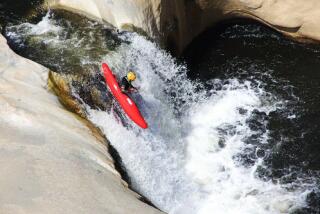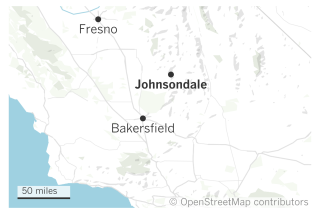Stroke of Tragedy
- Share via
Winds howling at 50 mph were ravaging the shallow lake, generating waves so intense in size and frequency that it was nearly impossible to resist panic.
Swimmers can’t panic. It wastes energy, changes breathing patterns, diverts attention.
“I didn’t see any boats, I didn’t see any buoys and I would estimate the waves were 6-8 feet,” Rachel Rudich said of conditions at the inaugural Ironman Utah triathlon June 8. “I realized this was survival mode. The drift, the waves, the current--I don’t know all that was going on out there, but it was nothing like anything I had experienced before. It was like wild surf from all directions that never stopped.”
Rudich couldn’t spot land because of the waves’ height. She was taking breaths quickly as water constantly smacked her face. Swimmers she’d encounter would immediately disappear on the other side of the flurry of waves. One man peered into her eyes and confided, “I’m just trying to stay close to you because I’m scared to death.”
By the time officials canceled the swimming portion of the event and cleared Utah Lake of the 1,536 participants, John Boland, 55, of Redondo Beach was dead and many others were grateful to be alive.
Right away, the notorious winds that transform Utah Lake near Provo into what locals call “Killer Lake” were whipping chaos across the waters.
Gusts were so strong that nearly every six-foot-tall buoy, anchored by two cinder blocks, had skidded wildly and indistinguishably far from designated positions.
The hundreds positioned at the starting point were confused by a lack of instructions. The uncertainty was so great that as many as half of the entrants began racing before a starting blast was fired.
“It was so dusty on the platform where we were supposed to enter the water that I had to put my swim goggles on to see,” said Rudich, a 45-year-old from Claremont attempting her fifth Ironman. “The start was a mess. They were trying to get people in the water, but you could barely hear the PA system because the wind was just so noisy. I was standing on the platform, where it was very crowded, then all of a sudden I heard the gun go off and someone yell, ‘Go!’ ”
The triathletes immediately confronted the stiffest winds possible, headwinds from the northwest. And minutes into the scheduled 2.4-mile race, the athletes were thrashing aimlessly, as far as a quarter-mile south of their assigned--and unmarked--path.
“The waves were coming so suddenly at me that every time I came up to breathe, I had a mouth full of water,” said Gilbert Mancilla, 31, of Phoenix. “It wasn’t long into the race, only about 500 meters, before I was telling myself, ‘This is too much for me.’ ”
Rudich, trying to remain calm, decided early in the race to switch from freestyle swimming to breaststroke.
Driving his 26-foot open-bow boat as an event volunteer assigned to place the course markers, Utah state senator and 30-year Provo resident Curt Bramble said he made earlier attempts to warn Ironman officials of the high winds’ typical effects on the lake.
“At 6 a.m., I asked an official if he was aware that the severe winds had been forecast,” Bramble said. “He basically dismissed me. I was told specifically, ‘You have no idea about this. These are world-class athletes who are used to six- to eight-foot ocean swells.’ ”
Said swim captain Rob Durrans: “Those of us who knew the lake knew that race should have never been started, but I had no one to express that to. I was out on the course in a boat with no radio when all the officials were at the starting line. When it started, I had no contact with any of them.”
Minutes after the 6:53 a.m. start, Bramble worked to get a better look at the developing chaos as waves broke across his boat’s bow.
He saw Mancilla yelling to be saved. He heard others screaming in frustration for accurate directions. He scanned the lake and saw no other boats positioned to assist.
“What I was trying to tell the officials is that there is a lot of difference in the amplitude of swells in a deep ocean to those on a seven-foot-deep lake,” Bramble said. “The number of waves is compressed on the lake. This is what I was talking about.”
Bramble’s inspection of the commotion made his pulse race. He barked words neither of his three passengers--his 19-year-old daughter, Mindy; a race official and an Ironman photographer--could hear because of the screaming winds:
“All hell has broken loose.”
Mancilla, a strong bicyclist and runner who said he learned to swim last summer so he could compete in triathlons, was desperate to see Bramble. Mancilla was so fatigued his soaking body had to be tugged aboard.
Bramble returned to the helm and quickly looked to his left.
He saw a body floating face down in the water.
“I pulled the boat close to him, thinking at first that he was either relaxing or had just gone unconscious,” Bramble said. “Because of the rough waters, there was no way I could grab him by the wetsuit, though. The body drifted under my boat.”
Bramble jumped in the lake and grabbed Boland’s lifeless body.
Mindy Bramble, who is CPR-trained, tried to revive Boland by pumping his chest and instructing Mancilla when to breathe.
“It was shocking,” Mancilla said. “I was like, ‘My God.’ I was on the verge of tears.”
Maria Hopp, a triathlon participant and a doctor from Littleton, Colo., hopped onto the boat to assist. Curt Bramble used a radio to inform officials on the shore, “I have an unconscious swimmer with no pulse,” as his powerful boat broke waves at top speed en route back to the harbor.
“I had to get right back to the race after I left Boland with the paramedics,” Bramble said. “The boat was moving at 50, 55 mph. There were some kayakers and surfboarders out there trying to help, but they were struggling. There was really nothing they could do in those waves.”
At shore, Rudich waited anxiously for the other 21 members of her Inland Inferno triathlon team.
“Being back on land was almost more terrifying,” Rudich said. “There were rumors of several drownings. The paramedics’ sirens were blaring. People were lying on the ground in exhaustion, and many others were very emotional.”
Bramble made three trips to pick up swimmers he described as “distressed,” loading 30 people on his boat the first time, 34 the second and 42 on the third.
“Do you know what getting 42 people on my 26-foot boat looked like?” Bramble asked. “How about a Haitian refugee camp?”
During the second trip, Bramble said the race official on his boat told him the swimming portion of the triathlon had been canceled. Officials had settled on a duathlon consisting of a 70-mile bicycle race and 13.1-mile run.
Bramble headed to Utah Valley Regional Medical Center in Provo to visit with Boland’s daughter, Jennifer James, and his girlfriend, Valerie Contreras.
A preliminary autopsy by Utah County medical examiners ruled that Boland, a retired computer programmer, drowned. A final autopsy report is expected before the end of June.
“My dad was always up for an adventure,” James said. “He never took the easy way out. He tried hang gliding, but he grew bored. He tried triathlons and loved them. He always thought it was a better challenge, and challenges made him happy. He was an inspiration.”
James and Contreras have scheduled a public memorial for Boland at 11 a.m. July 13 at Polliwog Park in Manhattan Beach.
They refused to discuss whether they plan to take legal action against Ironman Utah organizers, Ironman North America.
Ironman North America President Graham Fraser refused to comment for this story, spokeswoman Priscilla Fraiegari said. Fraser wrote on the group’s Web site that Ironman North America will permanently retire Boland’s race number (1596) and plans to establish a John Boland Foundation.
Lew Friedland, president of World Triathlon Corp., posted a letter on the Ironman Utah site. His first sentence was, “The last week has been the saddest and most difficult week in the history of the Ironman Triathlon.”
James defended her father against “a few callous claims on that Ironman site’s chat.” She was particularly irked by one comment, that “this was not a race for the weak.”
Boland, among 74 Ironman Utah entrants who were 55 or older, had finished three 100-mile Western States runs in Northern California, according to James.
The Ironman Utah was his seventh Ironman event. He finished the prestigious 1996 Ironman Triathlon in Hawaii.
“He understood the accomplishment was in finishing,” James said.
After the 2001 Ironman Malaysia, Boland posted his diary on the Internet.
In one passage regarding the swimming portion of the event, he wrote, “It’s the best-marked course I’ve ever seen [once the sun came up], and I still managed to weave around and get disoriented. I felt that I was doing OK, but the water was choppy and I had my usual sucky swim--1:57 according to the official time. I was so happy to get out of the water.”
Said James: “He was a strong swimmer. It was his weakest of the three events, and he would knock himself about it in a joking way. But he trained as a swimmer so much. He did ocean training. He took it very seriously and he worked very hard on it. I mean, he finished the Ironman Hawaii.”
James described Boland as a “wonderful, supportive” father.
“I’m a dancer, and I understand how difficult it can be for a parent whose child is pursuing a career in the arts, but he went in the backyard and built me a dance studio,” James said. “He had many friends.”
Contreras said the Utah triathlon was Boland’s first Ironman since Malaysia.
“He was nervous the night before, but excited and much more relieved in the morning,” Contreras said. “He told me, ‘I’m so happy the day is finally here.’ Then I became nervous.”
Bramble said he is not advising Boland’s family to sue Ironman North America.
He said the organization needs to reevaluate how it addresses race conditions and answer several questions.
“What was the driving force to start the race--lost entry fees [of $375], disappointed sponsors?” Bramble asked. “What motivated them to take these risks? Did they not have a weather report?
“It is untenable to me that they did not have a viable plan in place for dealing with the winds. They did not just ‘blow up,’ as I’ve heard them say. My question is, did they have a plan? I think the answer is no. There was no viable procedural manual in place, nothing safety-wise for the swimmers to rely upon.”
Bramble said his daughter, Mindy, couldn’t sleep for three days after administering to Boland.
“The first thing we all need to do is come to grips with the idea that someone has died,” Rudich said. “This is difficult to process for us. Triathletes know there are inherent risks and dangers to what we do. We won’t stop competing. But I’m certain the people who were in Utah will be wary about swimming in the open water for a long while.”
Sgt. Dennis Harris, the Utah Sheriff’s spokesman, said his department is investigating details of Boland’s death and detectives could conclude their findings in three to four weeks.
Boland’s death was the second drowning at Utah Lake this year.
“Utah Lake’s waves are quite dangerous when the wind is blowing,” Harris said.
“Really, it’s like any other lake, though. You have to do your best to be careful and you must have the appropriate safety equipment for the activity you are doing on the lake.”



